Caffeine is ubiquitous in modern American life. An incredible 85% of the U.S. population consumes at least one caffeCumulative Layout Shift inated beverage every day.[1]
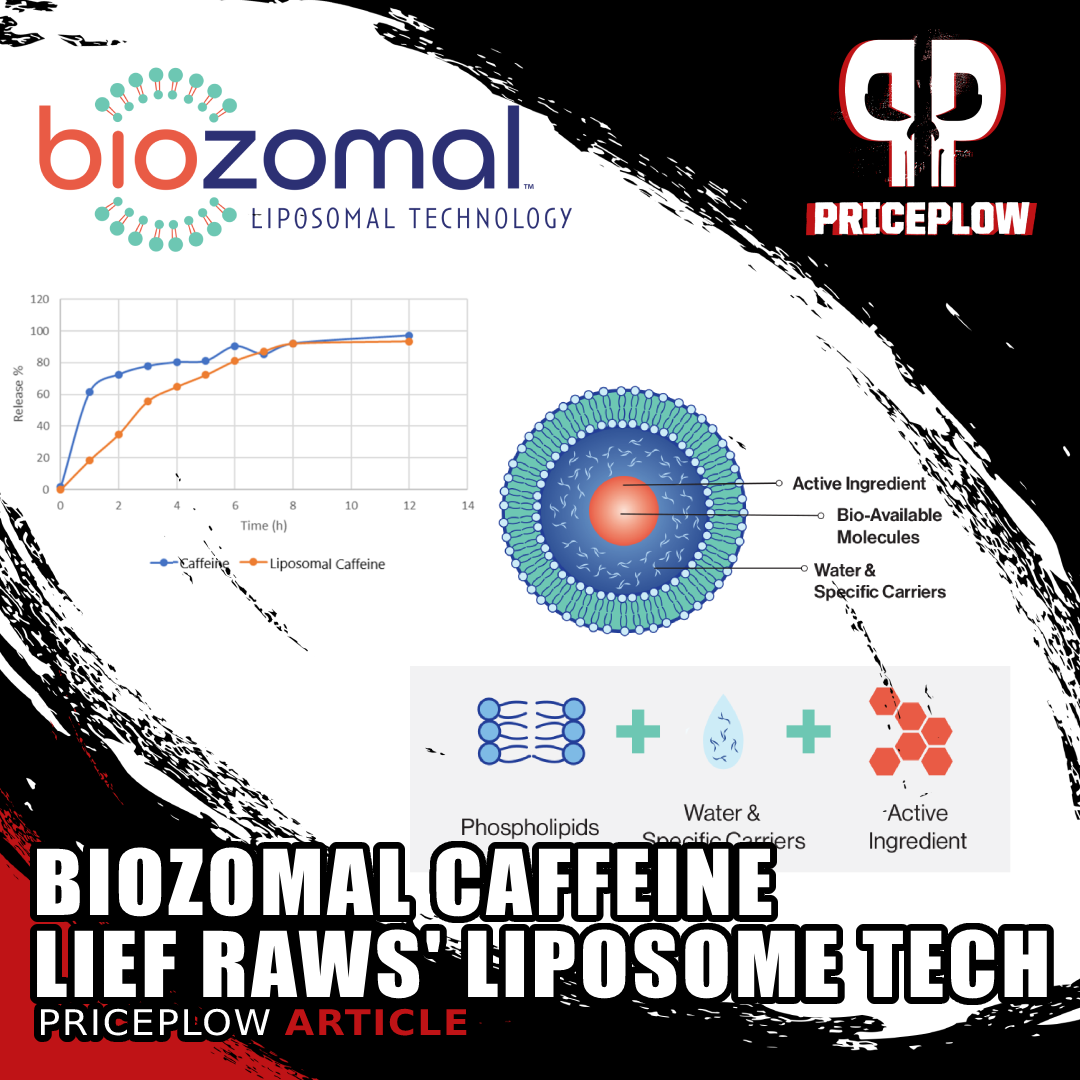
Lief Raws has a new type of Liposomal Caffeine for a sustained release -- Biozomal Caffeine. Learn how Biozomal Technology is not just your average lipid encapsulation!
It's easy to assume that something so common can't be improved, given how much time people spend thinking about fatigue-fighting ingredient. By now, all of the good ideas for making a better caffeine would have been executed, right? However – that isn't true!
The popular stimulant ingredient's next level-up has arrived.
Caffeine Can Still Be Better
Despite society's love for the ingredient, dietary supplement industry innovators are continually working to develop better forms of caffeine. Today we're going to talk about Biozomal Caffeine, a form of liposomal caffeine from Lief Raws that can greatly improve the caffeine experience.
Lief Raws is a quality-driven, science-focused ingredient supplier working to provide innovative ingredients to the food and dietary supplement industries.
You may recognize the name Lief -- Lief Labs is a premiere contract manufacturing facility that's cGMP-certified and both FDA-registered and NSF-registered. Lief Raws, the sponsor of this article, is the novel ingredient development company under their corporate umbrella. They have some incredible innovations, the first of which we'll cover is Biozomal Caffeine.
The details are below, but you can sign up for our Lief Raws and Biozomal Caffeine notifications to stay up-to-date on new products with the technology included:
Subscribe to PricePlow's Newsletter and Alerts on These Topics
Learn about Biozomal Caffeine in One Minute
Caffeine and the Energy Curve
The key to understanding the benefits of Biozomal Caffeine is the so-called caffeine energy curve – the graph of caffeine blood levels over time, starting from the moment you ingest it. We call it the energy curve because caffeine gives you energy, and the graph looks like a curve.
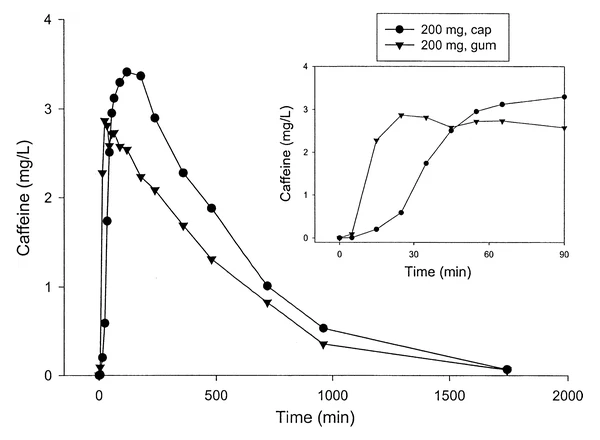
Typical pharmacokinetics of caffeine – the method of administration changes the rate and extent of absorption into the bloodstream.[2]
As you can see from the inset graph of pharmacokinetic data, oral caffeine administration causes a big initial spike in caffeine blood levels, after which it very gradually tapers off.[2]
Some people have no issues with this pattern of caffeine absorption – these people are typically fast metabolizers, meaning they have the genetics to process ingested caffeine very quickly. As a result, their caffeine blood concentrations peak lower, and drop faster, than slow or medium metabolizers.[3]
For anyone who's not a fast metabolizer, this pharmacokinetic curve can be a problem: the big initial spike combined with a slow taper can cause jitters and anxiety when the caffeine is taken, and withdrawal symptoms as it wears off.[3]
One can infer this from data, but there's no need: we hear this all the time in feedback from supplement consumers. In fact, enough people have trouble with caffeine that the supplement industry has begun to reverse course on its recent trend towards higher and higher doses of caffeine: now we are seeing many more caffeine-free and stimulant-free versions of products being offered as an alternative.
Biozomal Liposomal Caffeine: Smoothing Out the Energy Curve
Taking a look at the pharmacokinetic graph we've shared, it's evident that the delivery system for caffeine clearly affects the individual response to it. In the example given, caffeine from gum was absorbed less than caffeine from capsules – the initial spike was slightly more rapid, but the area under the curve (AUC), a measure of overall effect, was significantly smaller.[2]
This graph is a great demonstration of the general idea that we can significantly manipulate the pharmacokinetic properties of caffeine by enclosing it in different delivery systems.
So what if we had a way to smooth out this curve, with a lower peak and a more gradual taper? This could both give slower caffeine metabolizers a better caffeine experience, with longer-lasting caffeine that's not as aggressive, while providing faster caffeine metabolizers less reason to reach for yet another energy drink.
That's exactly the idea behind Lief Raws' Biozomal Caffeine. They've encased it in a liposome.
In Vitro Dialysis Study: Liposomes Slow Down the Dissolution of Caffeine
Before we get into the science of liposomes, let's talk about how Lief Raws is demonstrating that it works. The company recently carried out a membrane dialysis study showing that liposomes can significantly reduce the rate at which caffeine is dissolved into a solvent.[4]
Why does this matter? Because stomach acid is a solvent. The longer it takes for liposomal caffeine to dissolve, the more slowly it will be digested and absorbed.
In vitro membrane dialysis is one of pharmacology's gold-standard techniques for getting a general idea of how quickly something will dissolve.[5]
The way it works is simple: You have two compartments separated by a membrane: in one compartment is the substance you want to study, mixed with a solvent – in this case, that's liposomal caffeine, mixed with ethanol. In the other compartment is just the solvent (ethanol).
The law of osmosis tells us that once the caffeine is dissolved in the ethanol, it will naturally move across the membrane, into the other compartment, until the concentration of caffeine in both compartments is equal.[5] You can calculate the rate at which this happens by taking samples from the compartments at regular intervals.
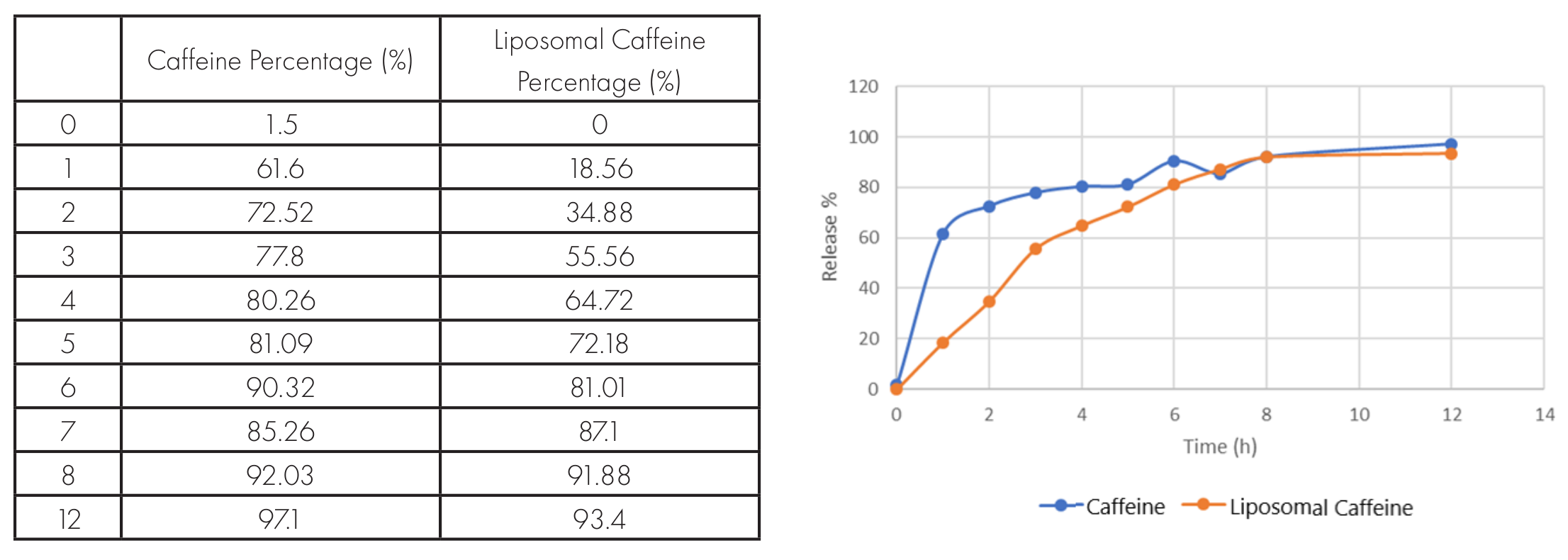
During an in vitro study, liposomes were found to reduce the rate at which caffeine is dissolved into an aqueous solution – implying that it will be digested by stomach acid more slowly.[4]
When researchers compared the liposomal caffeine's rate of osmosis to that of regular caffeine, they found that the liposomal caffeine moved across the membrane significantly slower than the regular caffeine control.
This means the liposomal caffeine dissolved in the ethanol solution more slowly than the regular caffeine did.
Remember – the caffeine has to dissolve before it can move across the membrane, because the membrane is only permeable to caffeine - the original liposome+caffeine doesn't fit.
Since the only difference was the liposomal package, this means that it was slowing down the rate at which the caffeine dissolved into the ethanol. This equates to slower dissolution in bodily fluids as well - remember, this is the gold standard technique for liposomal pharmaceutical drug development.[5]
While our intestinal walls can serve as a membrane, the biggest difference is that our body fluids contain stomach acids as our solvent. So let's look at the technology that slowed caffeine's release down:
How Liposomes Affect Absorption
So what exactly is a liposome?
It's a vesicle that consists of at least one lipid bilayer – basically an envelope of fat that encloses whatever drug or supplement you're trying to administer.
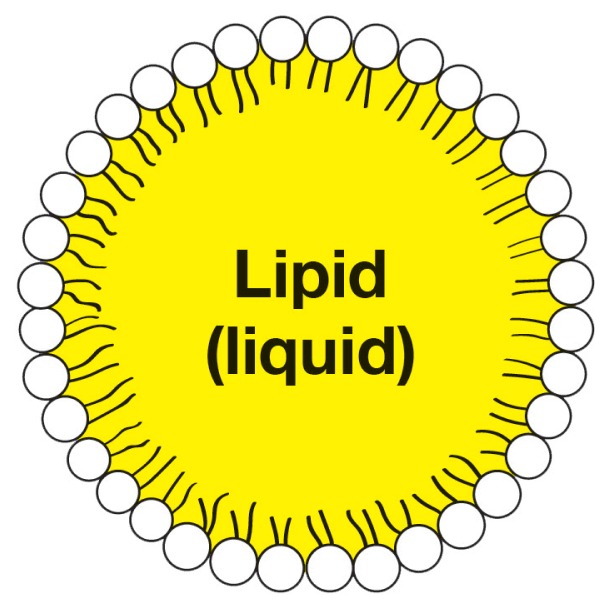
The structure of a liposome – phospholipids enclose a core of water, which can be used to dissolve water-soluble compounds like caffeine.[6]
The particular type of fat used for liposome construction is called a phospholipid. It consists of a hydrophilic "head", which contains a phosphate group, and two hydrophobic "tails". The technology works best when the liposome is a strong, uniform sphere -- nice and round.
Liposomal caffeine is basically produced by coating caffeine molecules in phospholipids.
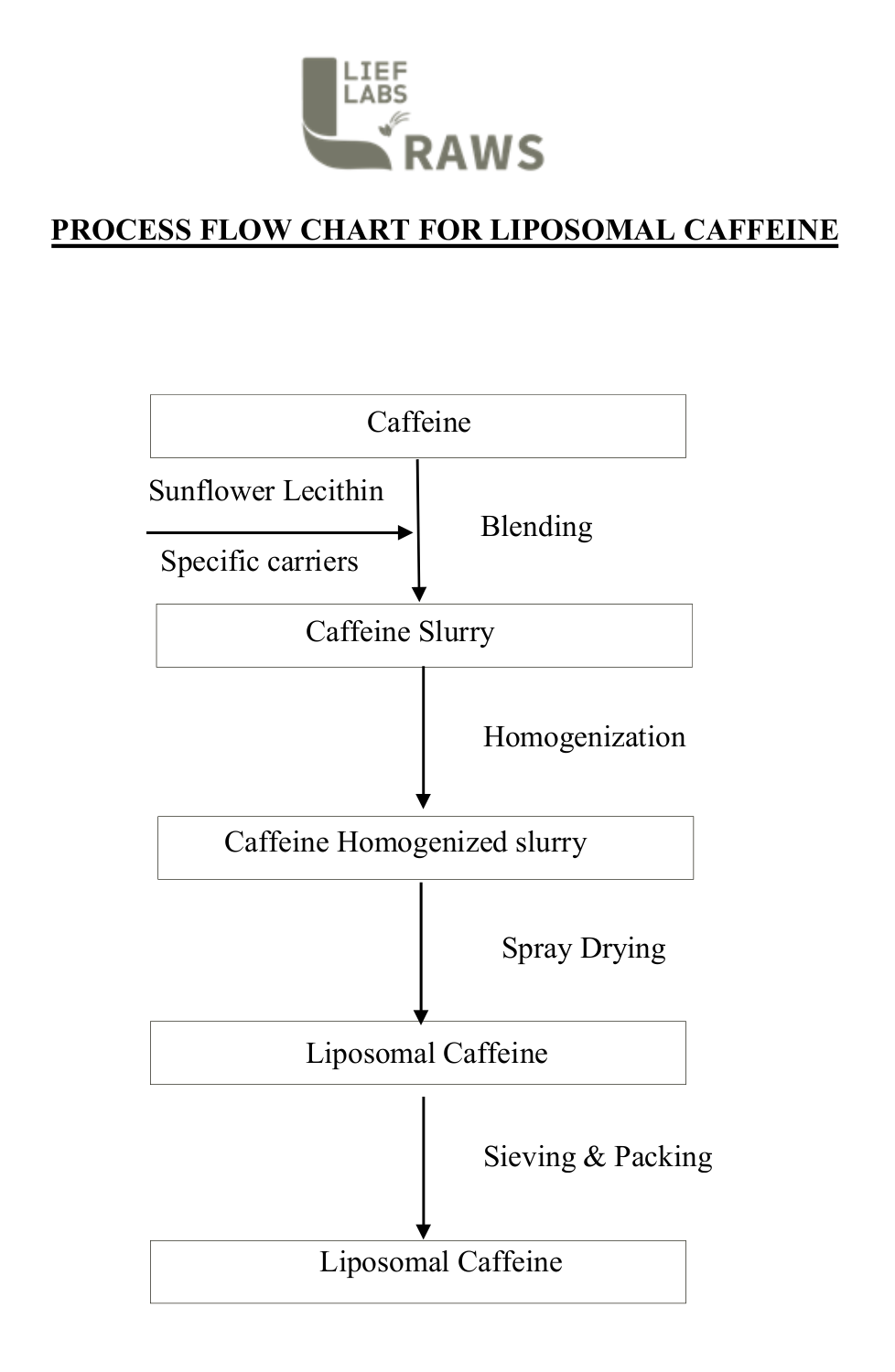
Lief Raws' process for creating liposomal caffeine: caffeine is blended with phospholipid-containing lecithin, and then dried. When re-exposed to water, the phospholipids self-assemble into a liposomal package.[7]
Then, when the phospholipids are exposed to water – say, when they are mixed with water, or ingested and make contact with saliva and stomach acid – the hydrophilic heads of the phospholipids are attracted to the water, and face outwards towards that water. Simultaneously, the hydrophobic tails are repelled by the water, meaning the water around the liposomal molecule forces the tails inward.
Now, if the phospholipids are surrounding a water-bound caffeine molecule, you'll get another layer underneath the exterior one – with the heads facing inwards and the tails facing outwards.
This gives you the phospholipid bilayer structure of the liposome, which is the technology Lief Raws is using with their Biozomal lineup.[8]
SEDDS: Self-emulsifying drug delivery system
The spontaneous self-assembling nature of the liposome classifies it as a self-emulsifying drug delivery system (SEDDS).
The mechanism by which the liposomal SEDDS slows down caffeine absorption is pretty simple: it's a barrier of fatty acids that your body needs to break down before the caffeine inside can be dissolved and utilized.
Here's how a 2009 study on the potential uses for SEDDS explains their mechanism of action:
"Self-emulsifying drug delivery systems (SEDDS) possess unparalleled potential in improving oral bioavailability of poorly water-soluble drugs. Following their oral administration, these systems rapidly disperse in gastrointestinal fluids, yielding micro- or nanoemulsions containing the solubilized drug. Owing to its miniscule globule size, the micro/nanoemulsifed drug can easily be absorbed through lymphatic pathways, bypassing the hepatic first-pass effect."[9]
The first-pass effect is the technical term for the phenomenon in which a drug is metabolized before it can be absorbed into the bloodstream.[10] This effect basically makes a drug less bioavailable, so we generally want to prevent it when possible.
Biozomal’s “Specific Carriers”
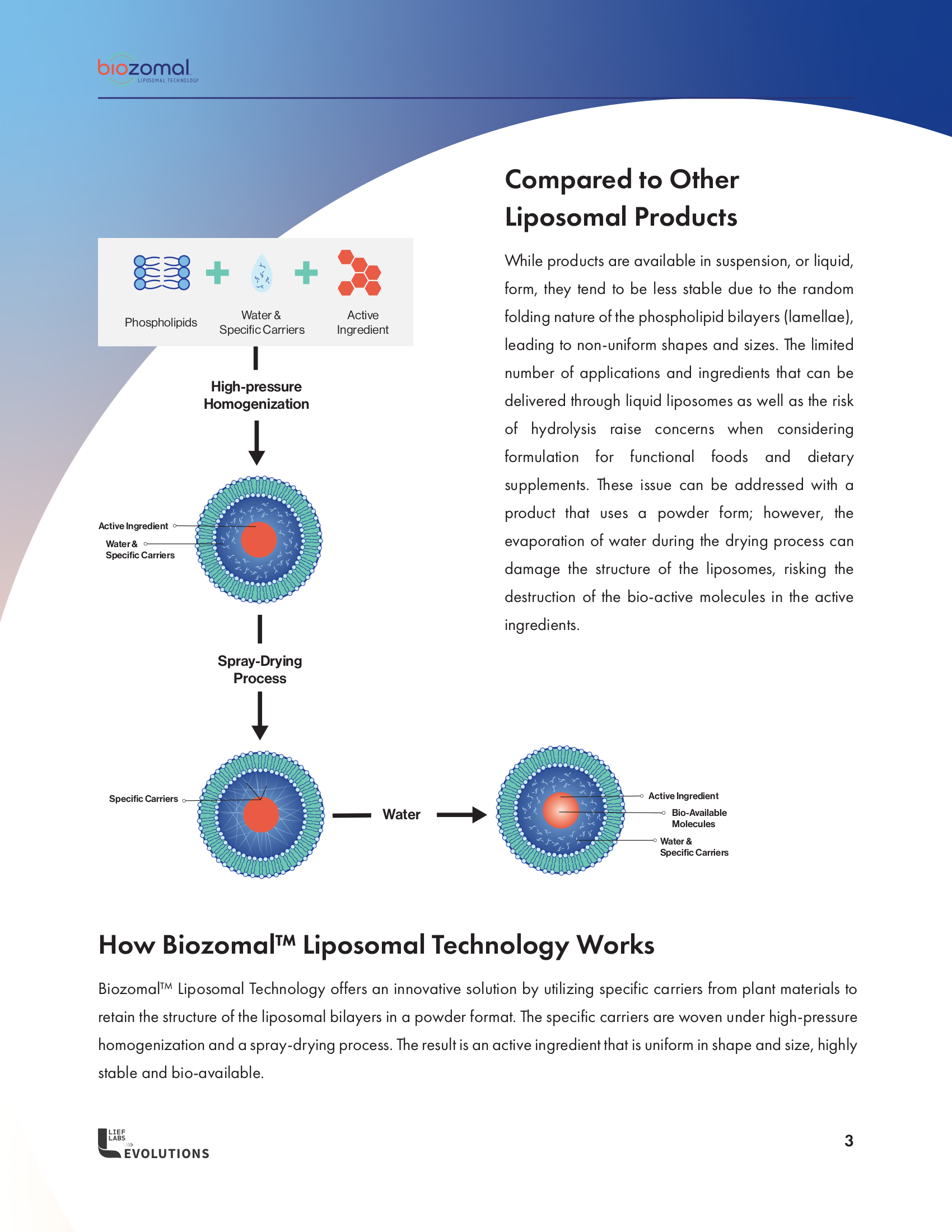
Specific carriers are molecules that help the liposomal package retain its structure after being dehydrated.[8]
You probably noticed in that diagram of the Biozomal production process that they mix something called a "specific carrier" in with the lecithin and caffeine. To understand what this is, we have to spend a little time thinking about what happens when a generic liposome is dried.
The problem with standard liposomes
When an ordinary liposome is dehydrated, it loses its structure. This is because the electrostatic forces between the water and the phospholipids' heads and tails are what produce the bilayer membrane structure. Take away those forces by taking away the water, and the bilayer envelope collapses.
Unfortunately, the interior compartment of the bilayer collapses with it, leaving some of the active ingredient exposed. When the liposomes are re-hydrated by a solvent, any exposed active ingredient is unprotected from the solvent, meaning it gets dissolved without the protection of the liposome.
Allowing this to happen would leave caffeine outside of the liposome when adding water to your shaker - not our intended. Lief Raws has the solution though.
Using specific carriers to keep caffeine in the liposome when adding water
This loss of active ingredient during rehydration is one thing that Biozomal is potentially avoiding through the use of molecules called specific carriers. The specific carriers help maintain the structure of the liposome even after it's been dehydrated, thus minimizing the amount of active ingredient lost to rehydration by keeping it enclosed in the liposomal bilayer the entire time.
Another issue is the potential for destruction of the active ingredient during the dehydration process – dehydration is typically achieved by exposing the liposomes to heat, so unless the active ingredient remains enclosed in the insulating layer of an intact liposome, it could be damaged by the heat and thus rendered useless.
How are they doing this? With an old friend of ours that everyone here should be familiar with: turmeric!
Folding turmeric into the process
Using a patented nanofiber weaving technology,[Patent Citation Requested] Lief Raws is using a turmeric extract folded into a constant stirring solution with the active ingredient (caffeine, in this case). It's homogenized at high pressure for uniformity (discussed in greater detail below), and then undergoes the spray drying process. The nanofibers are used as a strengthening phase - they're highly strong and crystalline, protecting the active ingredient during the spray drying process.
The curcumin in turmeric is well-known to be highly hydrophobic,[11] so we theorize that it's used as a way to create surface tension within the liposome, making it round, as intended.
The importance of homogenization
So now that we understand how crucial the structural integrity of the liposome is, we can better understand why homogenization is part of Lief Raws' Biozomal production process.
By subjecting the liposomes to very high pressure after their initial formation, Lief forces their shape into as perfectly round and uniform a sphere as they possibly can.
Here's how independent research from 2022 explains the liposomal homogenization process:
"In the homogenization method, the initial liposome suspension (composed of multilamellar liposomes) is continuously injected with a constant high pressure through an orifice, and collides with a fixed stainless-steel wall that causes downsizing of the liposomes. The formation of the liposomes' structure takes place due to cavitation, shear phenomena, and turbulence."[12]
High-pressure homogenization is of particular importance for the Biozomal technology, because the uniformity created by homogenization is one of the ways that specific carriers get folded into the structure of the liposome.
The result is a liposome that can withstand the high-temperature spray-drying process, and retain its structure until being re-hydrated. This protects the active ingredient on two different counts, and now you have a very powerful liposomal caffeine ingredient.
Liposomes May Even Increase Caffeine Bioavailability
Ordinarily, liposomal technology used to protect the enclosed molecule from being broken down by stomach enzymes and fatty acids.[13]
The oral bioavailability of caffeine is generally thought of as pretty good, so most probably wouldn't think that this is a concern here. However, if there's any possibility that we can eek out even more power from caffeine by bypassing the first-pass effect, we (as a society of caffeine-lovers) will gladly go for it.
And anecdotally speaking, Biozomal Caffeine feels stronger than most users expect. Even though it doesn't hit as fast or as hard, the overall effect is a bit stronger than we would have thought. Even the capsules containing just a 50 milligram total yield of caffeine that Lief Raws had sent us (this dosage is nothing in our world) provided more of a lift than we figured we'd achieve.
Prediction: Biozomal Caffeine will have a greater AUC than caffeine anhydrous
This is all conjecture -- and we hope that Lief Raws will perform more intense pharmacokinetic testing -- but we believe that the total area under the curve (AUC) of BioZomal Caffeine is higher than that of caffeine anhydrous.
It will certainly have a lower peak and will last longer. But if you take a look at the total caffeine load that actually makes it into plasma, it seems like this technology will get you more - especially if the liposome can avoid having some of it excreted too soon.
Time will tell, and right or wrong, this area will be updated if any data is presented.
Lief Raws is using Naturally sourced caffeine inside!
An additional thing we like about Biozomal Liposomal Caffeine is its utilization of naturally sourced caffeine. Specifically, the caffeine comes from green coffee beans, which are simply raw, unroasted coffee beans.
Why should we care? Understand how synthetic caffeine is made
Synthetic caffeine, on the other hand, can come from some very... unclean... sources. It's sometimes synthesized from tea-leaf extracts,[14] but that's become quite uneconomical at scale, especially given the amount of caffeine consumed versus tea the past few decades.[15]
So nowadays, xanthines like caffeine are produced by chemical synthesis using materials such as dimethyl urea and ethyl cyanoacetate.[16] Yes, these are chemicals related to urea and cyanide - you definitely better hope for very high yields and low contamination. Other synthesis reactions involve carbon monoxide and methanol or dimethyl carbamide and malonic acid.[17]
There are other methods for the chemical synthesis of caffeine, but their common denominator is the utilization of a mechanical process that involves industrial solvents, lubricants, and hazardous waste byproducts.
Understandably, many consumers want every assurance that no residues from this process are in their supplement, and many supplement formulators don't want there to be any potential for exposing their customers to those residues, either.
Done properly, natural caffeine sourcing can sidestep these issues. When processes like water osmosis are used to extract caffeine from green coffee, the result is pure, clean caffeine devoid of any toxic industrial residues.
Natural caffeine has less risk
The value proposition of using clean caffeine is clear: as the public becomes educated on the impact that industrial chemicals have on human health, more and more consumers are demanding transparency and purity in their food, beverages and supplements.
Often debated in our community is how natural caffeine affects users - many consumers claim that it doesn't "hit as hard", although that's never been confirmed.
Synthetic caffeine is chemically different
Skeptics will often insist that natural caffeine and synthetic caffeine are chemically identical, but recent research has conclusively demonstrated that this is false. In a 2012 study published by the American Chemical Society, researchers used a mass spectrometer to demonstrate that natural and synthetic caffeine can be reliably differentiated from each other based on carbon isotope ratios.[18]
We're not aware of any peer-reviewed studies comparing the safety or efficacy of natural caffeine to that of synthetic caffeine, but absence of evidence is not evidence of absence. Since natural and synthetic caffeine are analytically distinct, it stands to reason that potential differences in their impact on human health should be examined.
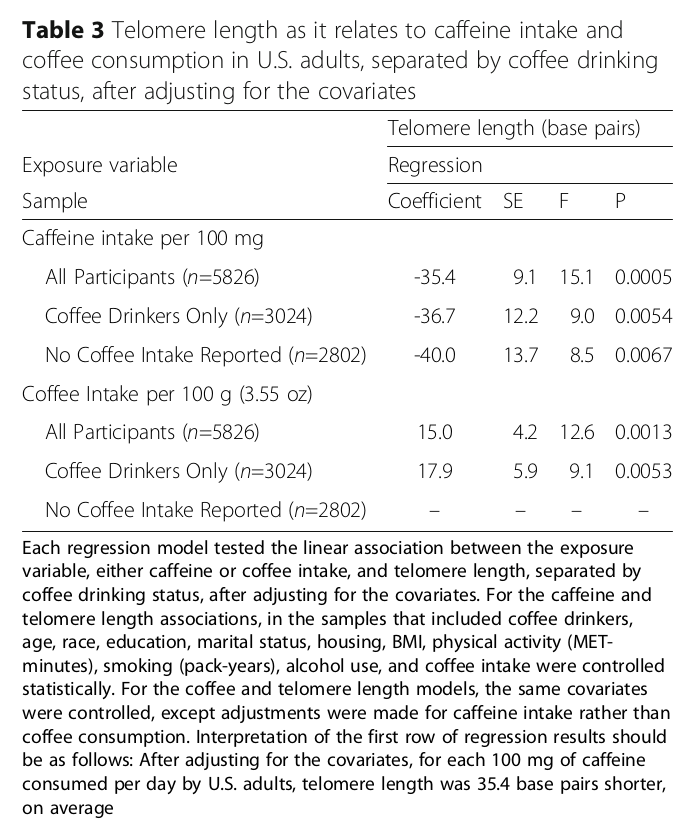
Synthetic caffeine-drinkers have shorter telomere length, while coffee drinkers have longer telomere length.[19]
One interesting study showed that natural caffeine drinkers (from coffee) have longer telomeres than those who get their caffeine from non-coffee sources.[19] Telomeres are the nucleoproteins that protect the ends of your chromosomes -- shorter lengths indicate more aging and negative health[20] with an increased risk of early death.[21] This isn't a direct comparison, because the coffee is likely providing additional benefits, but it's worth considering.
Speaking anecdotally, as industry connectors, we do get tons of feedback from supplement consumers on this subject: A significant number of our followers have sworn to us that natural caffeine is easier to tolerate, and more pleasant to use, than synthetic caffeine.
High impact supplement consumers – e.g., health-conscious social media influencers and industry insiders – are more likely than the average consumer to care about this, but the trend towards natural is clearly seen by some very large brands adopting it.
Now let's take a step back and ask why we're here in the first place -- for the benefits of caffeine:
Why We Care: Benefits of Caffeine
So why go to all this trouble in the first place? What's so great about caffeine that we'd want to
take it as a supplement?
As we alluded to earlier, caffeine is great at increasing alertness and fighting fatigue.[22,23] Let's explore its two main mechanisms:
-
Inhibition of adenosine
It does this by inhibiting the action of a nucleotide called adenosine, which builds up in your brain while you're awake and creates feelings of fatigue as it accumulates. This happens because free adenosine is released as a byproduct of adenosine triphosphate (ATP) consumption. Your brain cells consume lots of ATP while you're awake because the waking state is where we perform our most intense cognitive tasks.[24] We often call ATP the "energy currency" on this site.
Caffeine has three major metabolites, and one of them (paraxanthine) does most of the heavy lifting. Image courtesy Wikimedia
Caffeine doesn't actually stop adenosine from building up, though. To do that we'd have to inhibit ATP utilization, which we obviously don't want to do. However, it does block the adenosine receptor, which prevents adenosine from acting on your brain.[22,25]
Adenosine inhibition is a huge part of caffeine's anti-fatigue effect, and it's why, for example, you will probably brew yourself a cup of coffee if you have to burn the midnight oil at work.
-
Inhibition of phosphodiesterase
But caffeine can also increase cellular energy production, giving us "more energy" in the most literal possible sense. It does this by inhibiting an enzyme called phosphodiesterase, which is responsible for degrading (breaking down) a messenger molecule called cyclic adenosine monophosphate (cAMP).[22,25]
The function of cAMP is signaling to your cells that it's time to produce more energy. Your cells do this by burning the calories contained in glucose and fatty acids – so upregulating cAMP basically speeds up your metabolism, causing you to burn more calories in a day.[26]
Caffeine is especially good at increasing your body's rate of fat burning. Research shows that a 6 mg/kg dose of caffeine can increase fat burning by as much as 50%.[27]
Most of us will immediately recognize this as a great potential strategy for achieving and maintaining a lean body composition, something most of us want.
But it also gives you more fuel for the machine – fat is energy! This boost in cellular energy supply can translate to improved physical and mental performance.
How caffeine can improve mental and physical performance
As it turns out, caffeine is also a potent ergogenic aid, meaning a substance that can improve an athlete's physical performance, stamina, and recovery.
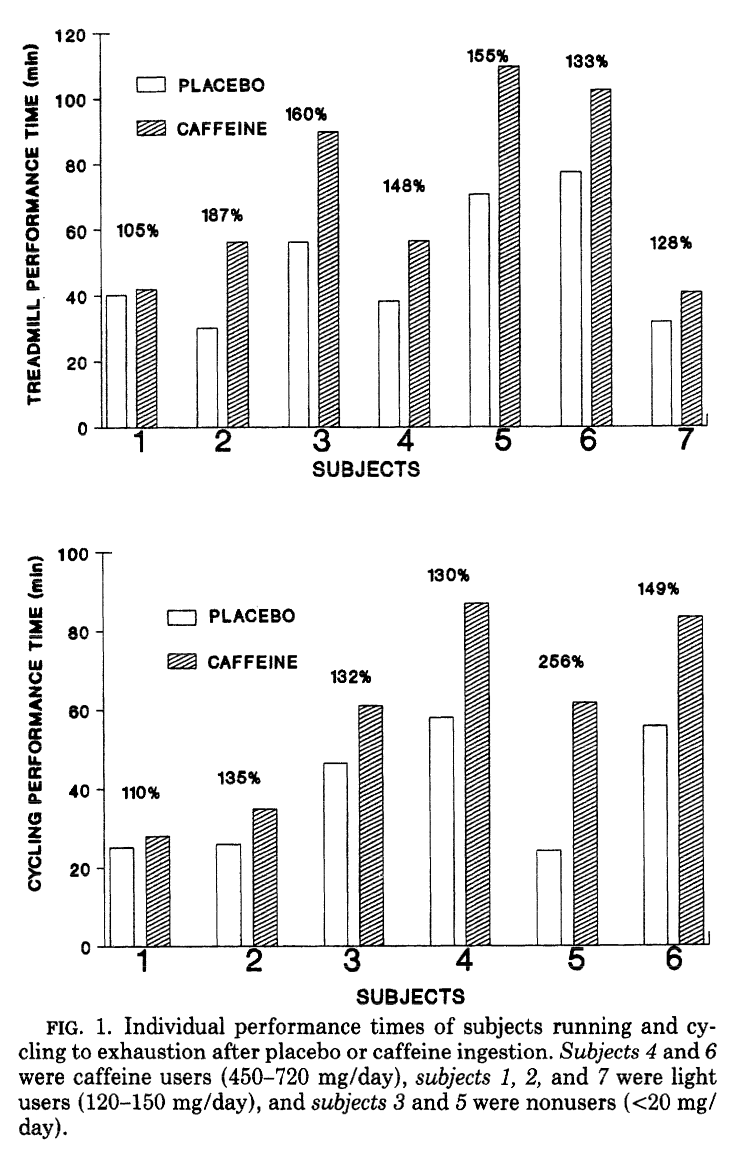
Known since 1991, very high dose caffeine can seriously boost performance.[29] As you can see, it's quite variable amongst users - future research would show that caffeine's effects depend on your genotype.
The pro-metabolic effect of caffeine boosts cellular energy, leading to slight but non-negligible increases to strength, athletic endurance, and top-end power with as little as 3mg/kg body weight.[28] But if you want to get a little bit more intense -- and this won't be for everyone -- there's even more research showing gains in the 5-9mg/kg dose range![29-41]
However, whatever caffeine dosing strategy you wish to consume on a given day, it doesn't all need to be Biozomal -- we discuss how it's generally blended in the next section.
Caffeine as a nootropic
Finally, caffeine can improve cognition – it's been shown to decrease reaction times, sharpen focus, and improve alertness.[23,42] It also has been shown increase working memory,[43] which is a primary factor in one's fluid intelligence.[43]
Biozomal Dosing: Caffeine Blends
As you can imagine, Biozomal Caffeine will be more expensive than natural caffeine, and certainly cost more than synthetic caffeine anhydrous. But not to worry - formulators don't need to use it as the only caffeine source. We often see supplement formulators using a blend of ordinary caffeine anhydrous and the delayed release caffeine.
The reason for this is that it can give the consumer the best of both worlds: fast-acting caffeine for an immediate energy boost, and then the delayed release to help smooth out the taper, thus decreasing the potential for caffeine withdrawal symptoms.
That's how we'd expect to see Biozomal Liposomal Caffeine used – e.g., a 2:1 ratio of anhydrous to liposomal for high-stim applications, and more of a 1:1 ratio for lower-stim applications.
Yield – 25% by weight
If you're trying to do the math on what exactly what would look like, know that Biozomal Liposomal Caffeine is about 25% caffeine by weight – a 100 mg serving of Biozomal Caffeine yields 25 milligrams of pure natural caffeine.
This is low compared to other forms of caffeine, but remember that it's encased in a complex liposome - this isn't just binding it to some acid or putting some sunflower lecithin next to it!
So an example pre-workout formulation could have the following:
- 400 milligrams of Biozomal caffeine (yielding 100 milligrams of caffeine)
- 210 milligrams of natural caffeine (yielding ~200 milligrams of caffeine)
This yields 300 milligrams of total caffeine - a pretty solid hit -- but would also fit into just one capsule if needed.
Other Applications and Advantages of Biozomal Liposomal Technology
Caffeine isn't the only supplement that we've seen formulated with Biozomal Liposomal technology. Other examples include:
- Glucosamine
- Hyaluronic Acid
- Curcumin
- B Vitamins
- Zinc
- Vitamin C
Specific carriers and shelf-life
Although pure caffeine is pretty shelf-stable, there are plenty of other ingredients that aren't, and we think their shelf lives could potentially be extended through the application of Biozomal Liposomal technology.
Because of the potential for dehydration and rehydration to alter the structural integrity of liposomes, long-term storage of liposomal formulations has proven challenging.
The instability of liposomes in an aqueous solution (thanks to constant ongoing hydrolysis) has traditionally been a regulatory hurdle for liposomal formulations, many of which have been recalled due to issues with peroxidation and spoilage.[44]
This is why liposomes are sometimes stored in a dehydrated form and then rehydrated as needed,[44,45] but again, this comes with problems of its own – normal liposomes can be expected to lose their structure when removed from water, thanks to the collapse of the electrical forces that act between the water and the hydrophilic-hydrophobic structures of the phospholipid.
For this reason, liposomes are sometimes lyophilized. In lyophilization, liposomes are frozen and then placed in a vacuum, which allows the water to turn directly from solid into vapor, without ever passing through the liquid phase.
Done properly, this can help preserve the structure of the liposomes, making them more shelf-stable.[44,45]
However, the freezing itself has the potential to damage liposomal membranes,[44,45] so it's not ideal.
That's why using specific carriers to maintain liposomal structure instead is so cool. Specific carriers are an alternative to lyophilization. Their use obviates the time-consuming, expensive and potentially damaging process of freeze-drying.
Again, this isn't a huge concern for caffeine, but if you're storing something highly prone to oxidation, specific carriers can go a long way towards protecting it and thus enhancing its shelf life, and Lief Raws may have a solution for your ingredient.
Biozomal Caffeine: Liposomes Done Right
Liposomal technology is very interesting – it makes perfect sense for an ingredient like caffeine, which has lately been plagued by negative feedback from consumers who complain about an overwhelming effect followed by debilitating withdrawals.
The industry response has been to cut back on the dose, but we think technologies like Biozomal Liposomal Caffeine are a more interesting alternative.
Smoothing out the caffeine energy curve gives us the best of both worlds – mental and physical performance benefits from caffeine, without the shocking onset or obnoxious taper.
But again, one of the most promising applications of this Biozomal Liposomal technology is in improving the shelf stability of certain ingredients, thanks to the way that their use of specific carriers can help maintain liposomal structure in the face of dehydration.
To learn more, see LiefRaws.com, and be sure to sign up for PricePlow's news alerts on all things related to Lief Raws and Biozomal Caffeine:
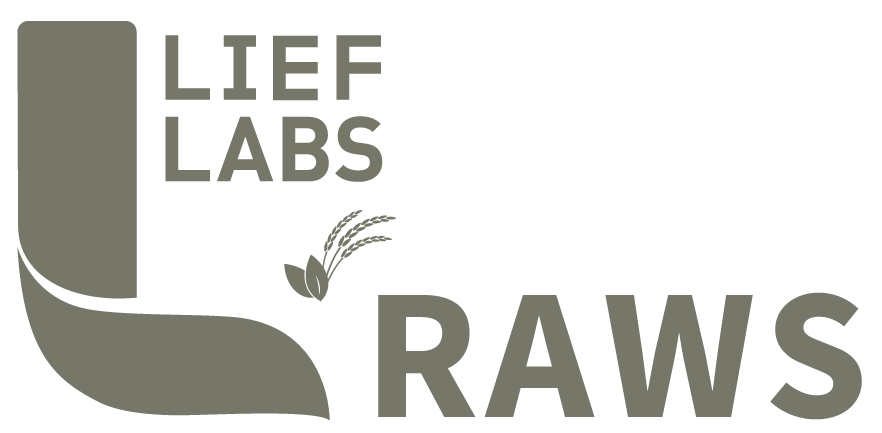
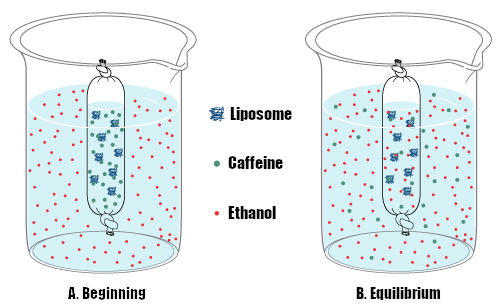
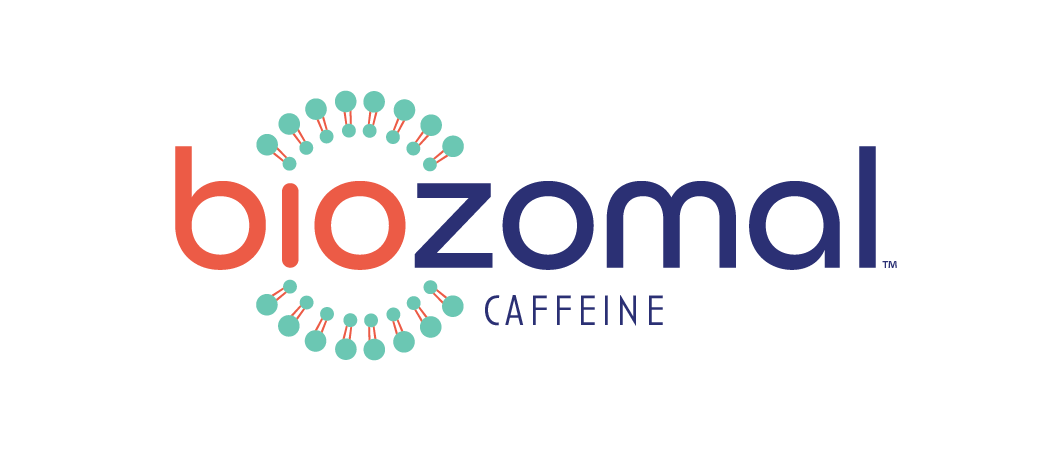
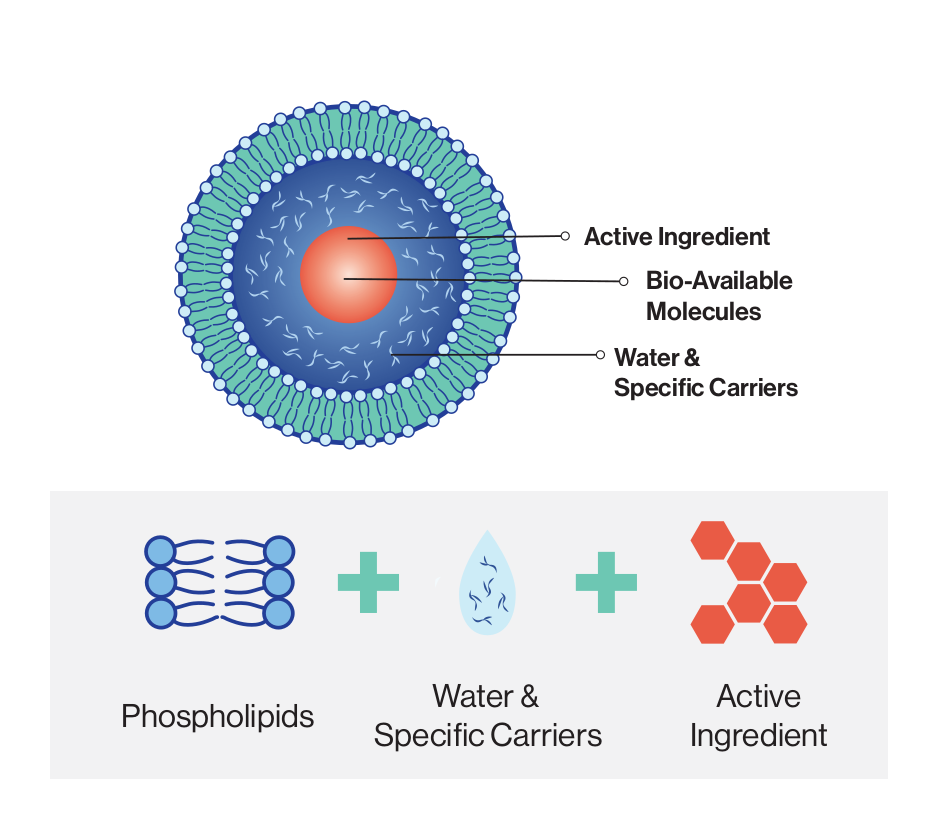
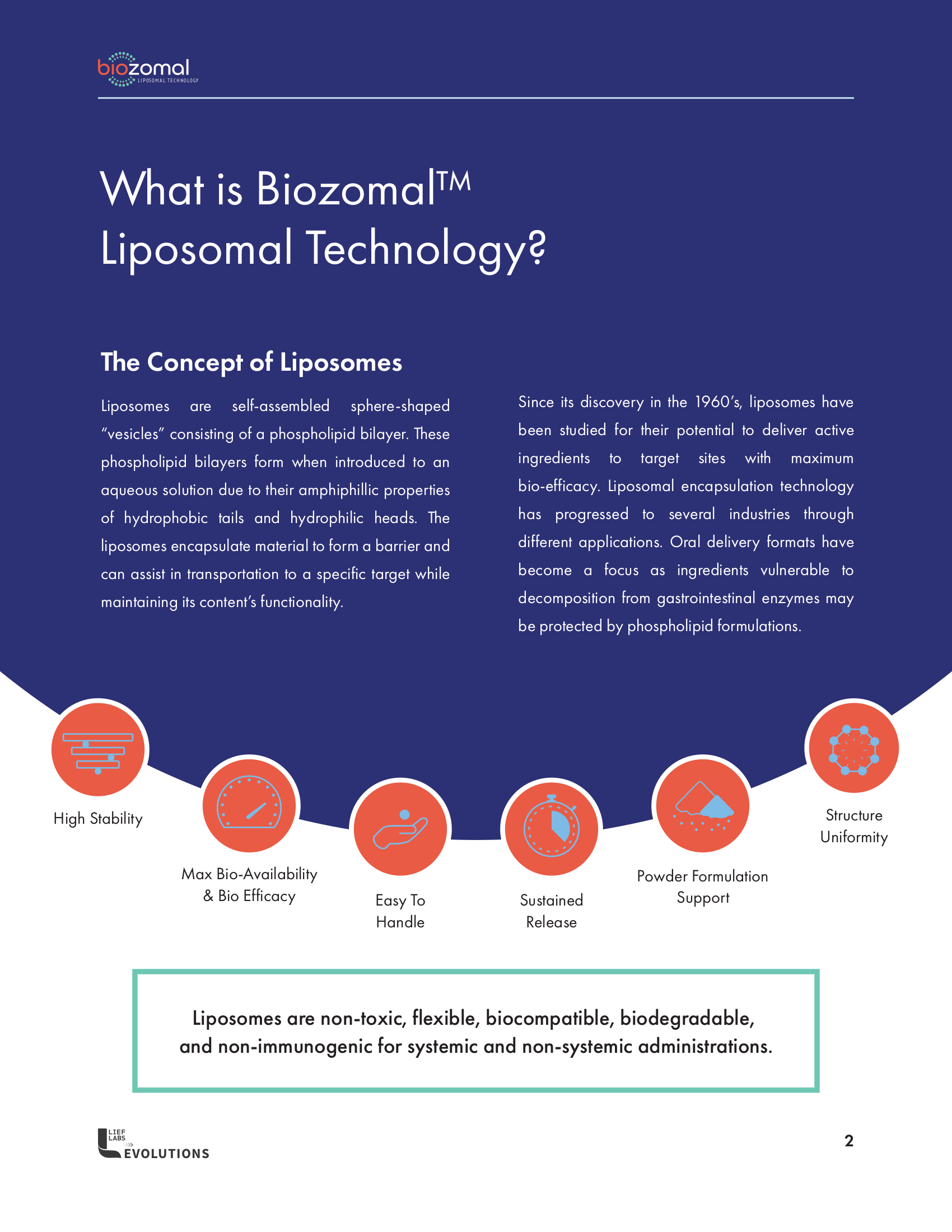
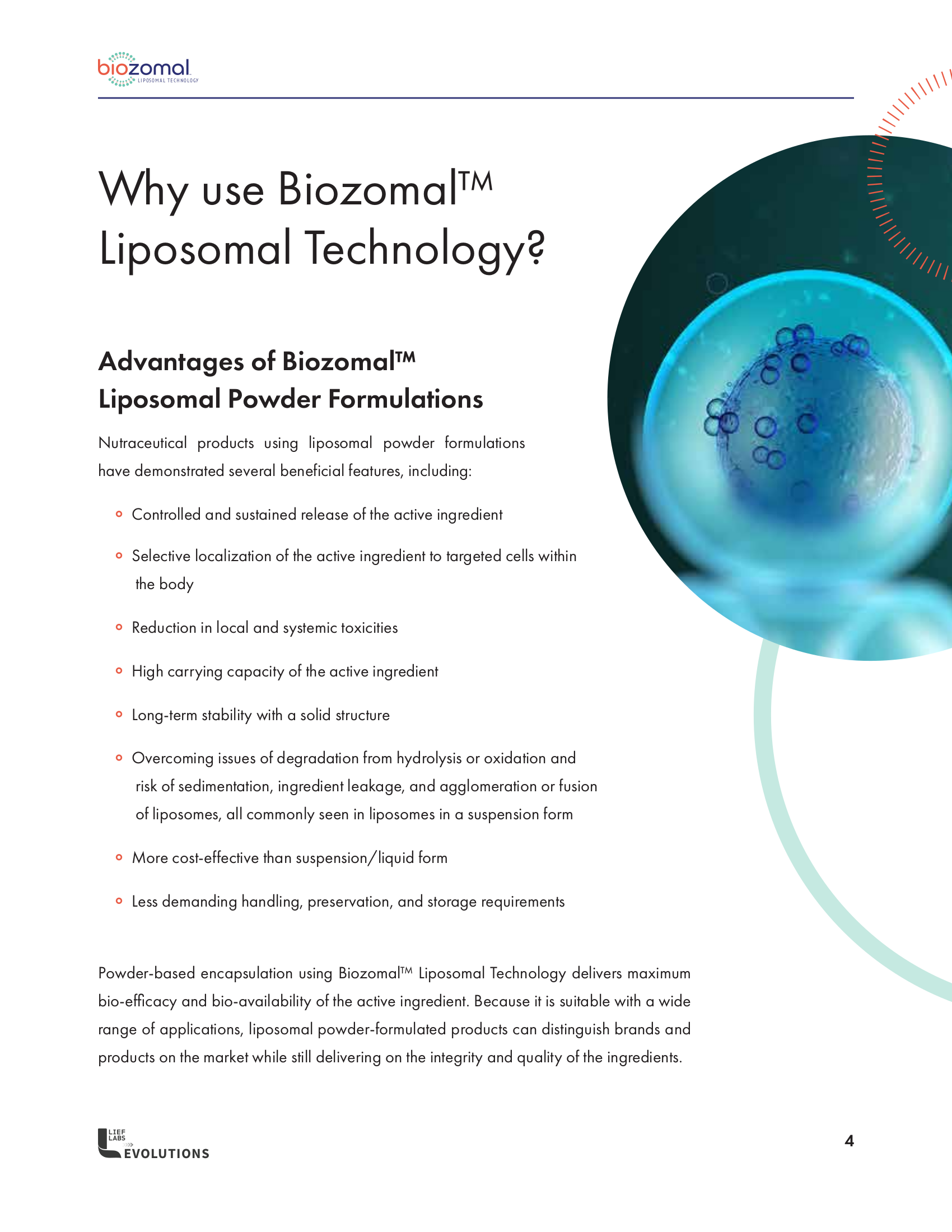

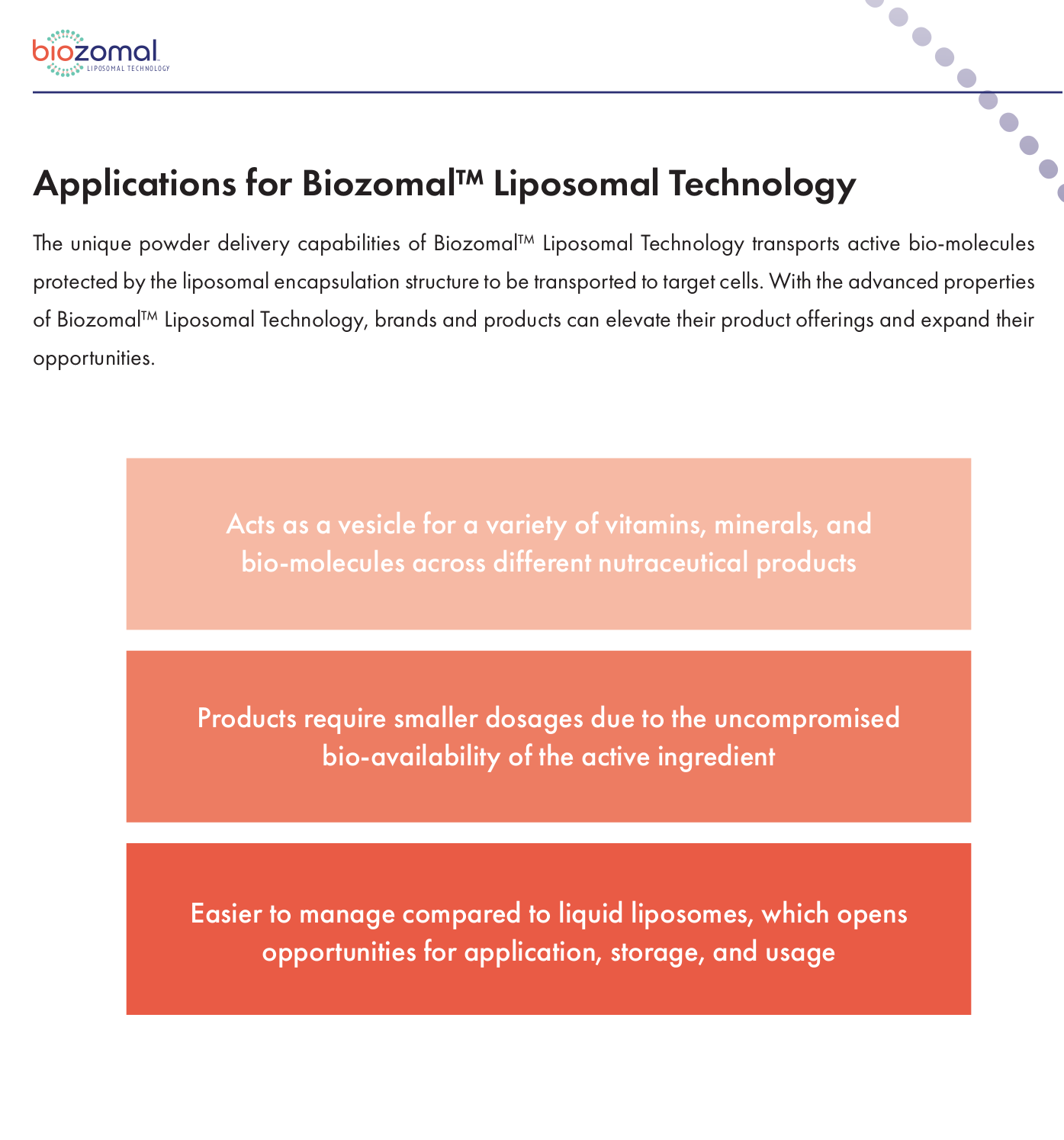
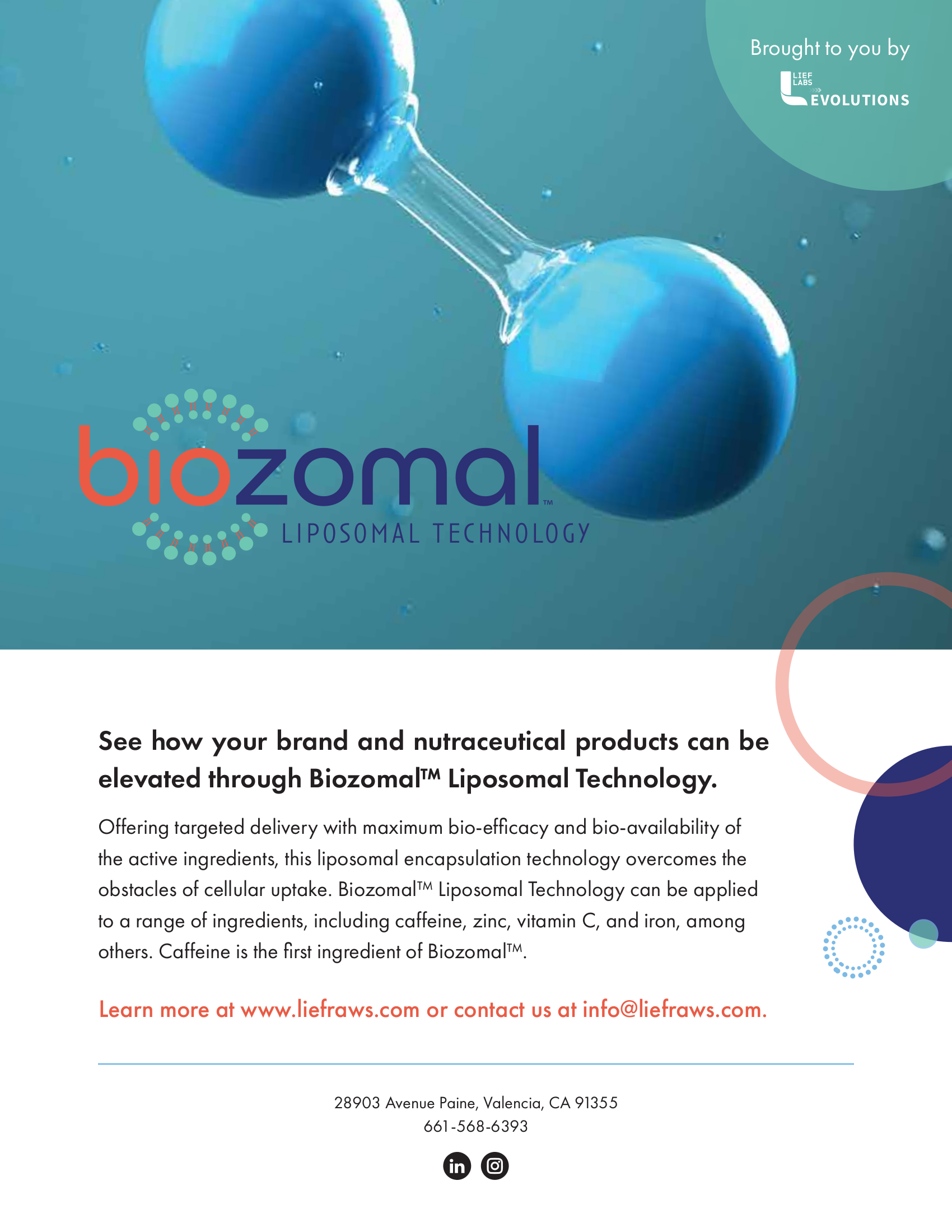
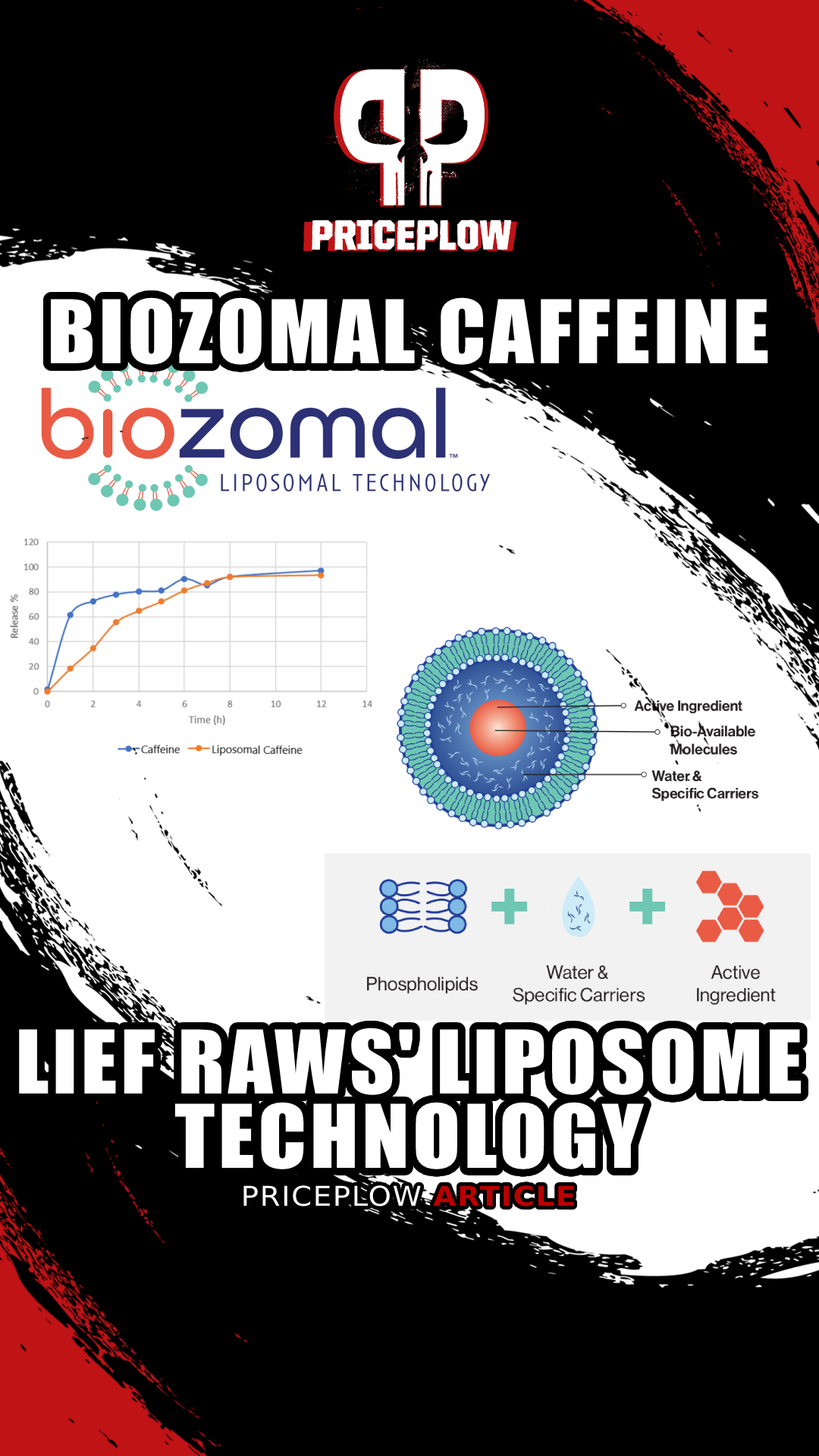


Comments and Discussion (Powered by the PricePlow Forum)